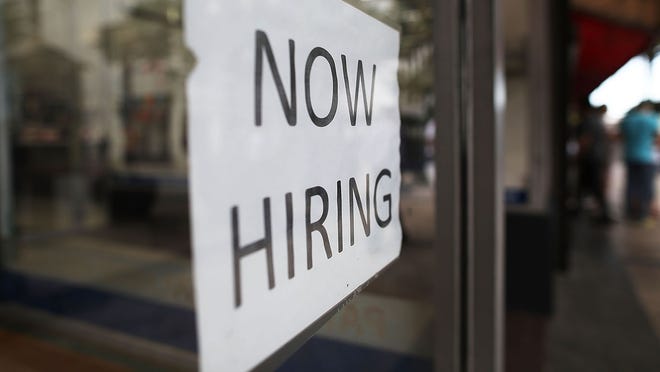

Americans quit jobs at a record pace in November as job openings hovered close to their all-time highs in a sign that workers continued to hold most of the leverage before the omicron variant sent COVID-19 cases soaring.
The number of workers quitting jobs vaulted to 4.6 million from 4.2 million, above the prior record of 4.4 million reached in September, the Labor Department said Tuesday. That means 3% of workers voluntarily left their positions, matching September's record high.
Employers posted 10.6 million job openings, down from a near-record 11 million the previous month and just below July’s all-time high, Labor said in its Job Openings and Labor Turnover Survey. Openings have topped 10 million for six straight months.
The decline was fueled by a drop of 261,000 openings in restaurants and hotels. "Employers were likely struggling to determine the impact of the omicron variant on their hiring needs," Contingent Macro Research wrote in a note to clients..
Still, since there were 6.9 million unemployed Americans in November, that means there were 1.5 available job vacancies for each unemployed person, the most on record dating back two decades.
The number of hires jumped from 6.5 million to 6.7 million, the highest level since July, in a possible signal that employers’ struggles to find workers eased a bit as some Americans returned to the work force.
A confluence of forces has left workers with most of the bargaining power.
Consumer demand has been surging as the economy continues to rebound following the pandemic-induced recession and government shutdowns, driving openings to record highs.
Meanwhile, many Americans are still on the sidelines, squeezing the labor supply. Some parents are still caring for young children because they can’t find or afford child care. Other people are afraid of contracting COVID-19, especially with the emergence of omicron, a more infectious but milder variant.
And many people can put off their return to the work force because they’re still living off government stimulus checks or generous unemployment benefits doled out earlier in the health crisis.
Many employers, in turn, are lifting wages and offering signing bonuses and other perks to entice workers at other firms to jumps ship.
Employees are doing so in record numbers to take advantage of the abundance of job openings and higher pay.
In November, job quitting leaped from 761,000 the prior month to 920,000 in restaurants and hotels, the industry hit hardest by job losses and worker shortages during the health crisis. Quits rose from 606,000 to 660,000 in education and health services; from 953,000 to 996,000 in trade, transportation and utilities; from 113,000 to 154,000 in financial activities; and from 730,000 to 798,000 in professional and business services.
The balance of power could shift slightly in 2022. The supply of workers is likely to grow as the health crisis wanes and Americans sidelined by COVID or childcare duties resume their job hunts, says economist Kathy Bostjancic of Oxford Economics.
Also, consumer demand could soften modestly after the economy has fully reopened, tempering the number of job openings, Indeed, a top job site, said in a report.
Other changes could be more enduring. Most of the 5 million people who have left the labor force since the start of the pandemic are over 55 and have retired – early or naturally, Goldman Sachs says. Others are switching careers or industries, for example, from restaurants and hotels to technology and warehousing, leaving some sectors with lots of openings and fewer candidates to fill them.
The upshot: Worker shortages are likely to persist but ease somewhat this year, Bostjancic says. As a result, job openings and quits could fall further from their highs but stay elevated.
“The short-term outlook for the labor market suggests workers are likely to continue to have considerable bargaining power in 2022,” Indeed says in its report.
A closer look at why workers are quitting:
Working remotely
Fifty-four percent of workers surveyed by ZipRecruiter in September said they preferred a job that let them work from home. Only about 10% of jobs offer that option, though that’s up from 3% before the pandemic, ZipRecruiter Chief Economist Julia Pollak says.
Many employees, in turn, are leaving jobs that require them to work in offices, says Jim McCoy, senior vice president of talent solutions at ManpowerGroup.
That could eventually prod more companies to allow remote work, Pollak says.
Upset with COVID-19 work experience
Nineteen percent of workers said they’re unhappy with how employers treated them during the pandemic. This could include those who burned out after being forced to work long hours while colleagues were out or are in stressful industries such as health care.
Switching careers
Twenty percent of workers surveyed by Joblist quit jobs to pursue new career paths, and their passions.
Many restaurant and retail workers, in particular, grew weary of the low pay and health risks that came with their jobs. I
About 25% of hospitality workers surveyed by Joblist said they wouldn’t want to work in the industry again.
And 20% of all workers say the pandemic caused them to change the kind of role they were seeking to one that permitted remote work, a ZipRecruiter survey shows.
Work-life balance
Thirteen percent of workers quit because their jobs didn’t provide work-life balance, the Joblist poll reveals.
Starting their own business
One-third of workers quit jobs to launch businesses, a Digital.com survey shows.
Source link








